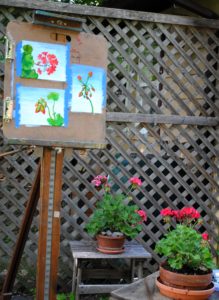
Plein air painters often use Liquin™ or other quick drying (alkyd) mediums in the field for that reason—they dry fast, usually in at least half the time it takes linseed oil to dry. I’ve never tried using them until now, partly because of what the are made of. Alkyds are petroleum soluble synthetic polyester resins derived from various alcohols and acids, which basically means you’re dealing with a form of plastic; they may not be as “plastic” as acrylics or your water bottle, but they are plastic nonetheless.
You can see my prejudice here! Sorry about that. However, given that plastic bags are found to last a very long time in landfills, maybe art painted with alkyd mediums may also last longer…?
For plein air sketching and painting in general, alkyds definitely have a leg up on regular plant oils (like linseed oil) due to their fast drying qualities. There are some good discussions on the internet, although, like so many internet discussions, they tend to be all over the place and about very specific items; you have to know the right question to ask to get started.
Testing Alkyds
I did a test. Here are my results:

Doing three small paintings at one time in my backyard meant I had a good, immediate basis of comparison. (Later, I found that my observations were backed up by what artists were saying in various internet sites, the best being referenced below).
W&N Liquin™ Fine Detail was a linseed oil lookalike; it has similar viscosity and painted smoothly on the paper. I paint with thick paint (often with no medium at all) and in terms of use felt no major difference between this and linseed oil. The paint also looked as if I were using linseed oil. But it dried noticeably faster—no fast enough during the painting process, as you can see from my little trial painting, but it was sticky the next day and basically dry within 18 hours.
W&N Liquin™ Fine Gel was quite different. First it is a slighty runny gel, and that weird half gel consistency remained on the palette. When mixing it with paint and brushing it onto the paper, I found the paint color unsaturated and thin, rather like painting with watercolors. In fact, the whole effect on the paper was that of watercolor, and this would be a great medium for a “watercolor look” to an oil painting. I had to use several layers of paint to reach the color saturation you see in this trial piece. Also, this is clearly a good medium for painters who like to have a very smooth finish with no “impasto effect” from the paint. It also dried noticeably faster, even while painting (much less leakage).
G Neo-Megilp is a pretty stiff gel in the bottle, but on the palette it mixed well with paint and paints on very smoothly. In overall effect, from my experience here, it was somewhere in between the two Liquins. It enabled thicker paint on the first round and so gives an oil painting, rather than watercolor, look at first brush. It also stays as a gel on the palette. One of its benefits in the field would be that as it is a stiff gel, there is nothing to spill or leak. But like the Fine Detail Liquin, it takes longer to dry, but nothing like linseed oil! The picture was also essentially dry within 18 hours).
Here are the pictures I painted:
Here are the results:
Note: I dried my pictures indoors, not in the sun. If in the sun, I assume they would have dried faster. My drying times:
Medium After 12 hrs After 18 hrs After 24 hrs Paint
L fine detail Sticky Mainly dry 99% dry Thickest paint
L light gel Dry Dry Dry Thin paint
G megilp Sticky Mainly dry Dry Thick paint
The only part that wasn’t dry by 18 hours in both pictures was the blue sky where the paint was thick (cobalt blue & titanium white); after 24 hours the thickest parts of this sky area still was still a bit tacky, but totally dry elsewhere.
For more and observations and information on these products, I found the following sites useful:
http://www.wetcanvas.com/forums/showthread.php?t=569515
http://www.wetcanvas.com/forums/showthread.php?t=310663
http://rachel-shirley.blogspot.com/2013/01/im-confused-about-alkyd-mediums-for-oil.html
http://helloartsy.com/why-i-stopped-painting-with-liquin/
http://www.gamblincolors.com/mediums/
Notes
Although artists often use the term “liquin” to refer to any alkyd medium, like the commonly used word “Xerox”, it actually is a trademarked name ( owned by Windsor & Newton)
Wikipedia has a good description of alkyds:
An alkyd is a polyester modified by the addition of fatty acids and other components. They are derived from polyols and a dicarboxylic acid or carboxylic acid anhydride. The term alkyd is a modification of the original name “alcid”, reflecting the fact that they are derived from alcohol and organic acids. The inclusion of the fatty acid confers a tendency to form flexible coating. Alkyds are used in paints and in moulds for casting. They are the dominant resin or “binder” in most commercial “oil-based” coatings. Approximately 200,000 tons of alkyd resins are produced each year. The original alkyds were compounds of glycerol and phthalic acid sold under the name Glyptal. These were sold as substitutes for the darker colored Copal resins, thus creating alkyd varnishes which were much paler in colour. From these, the alkyds we know today were developed.



